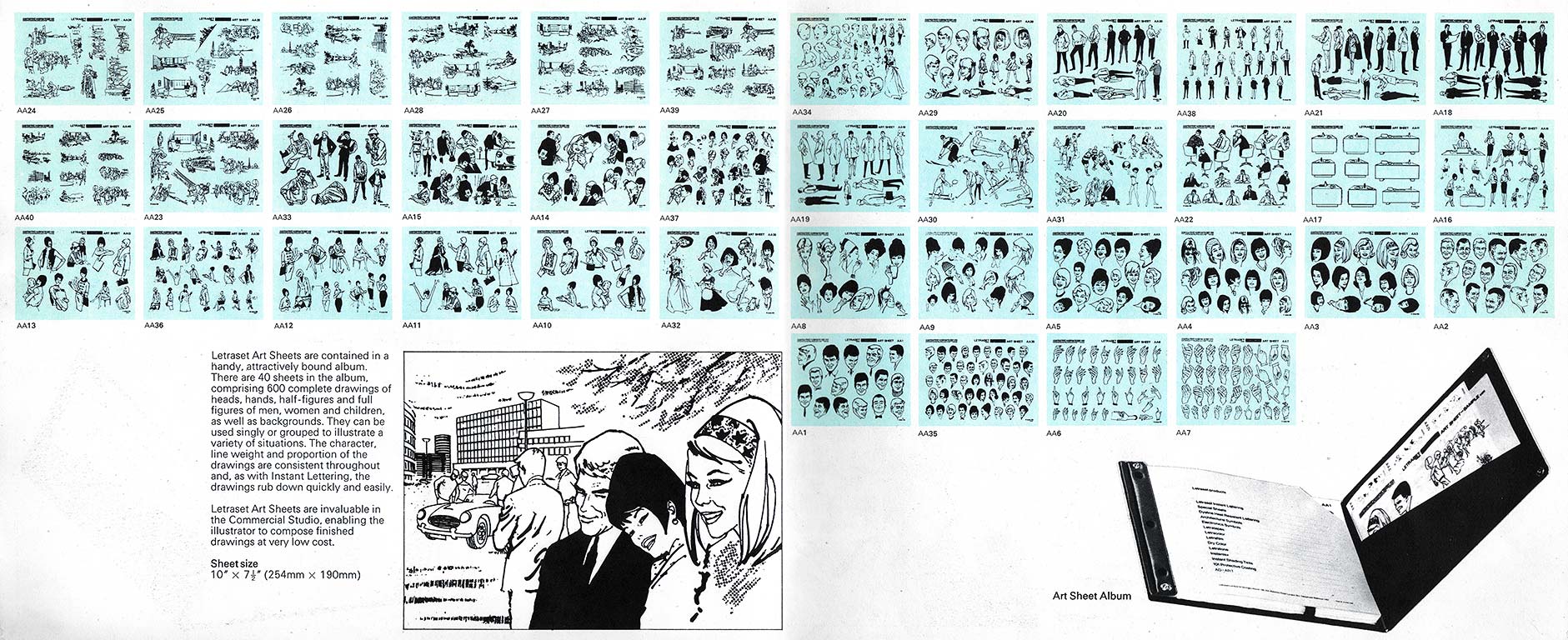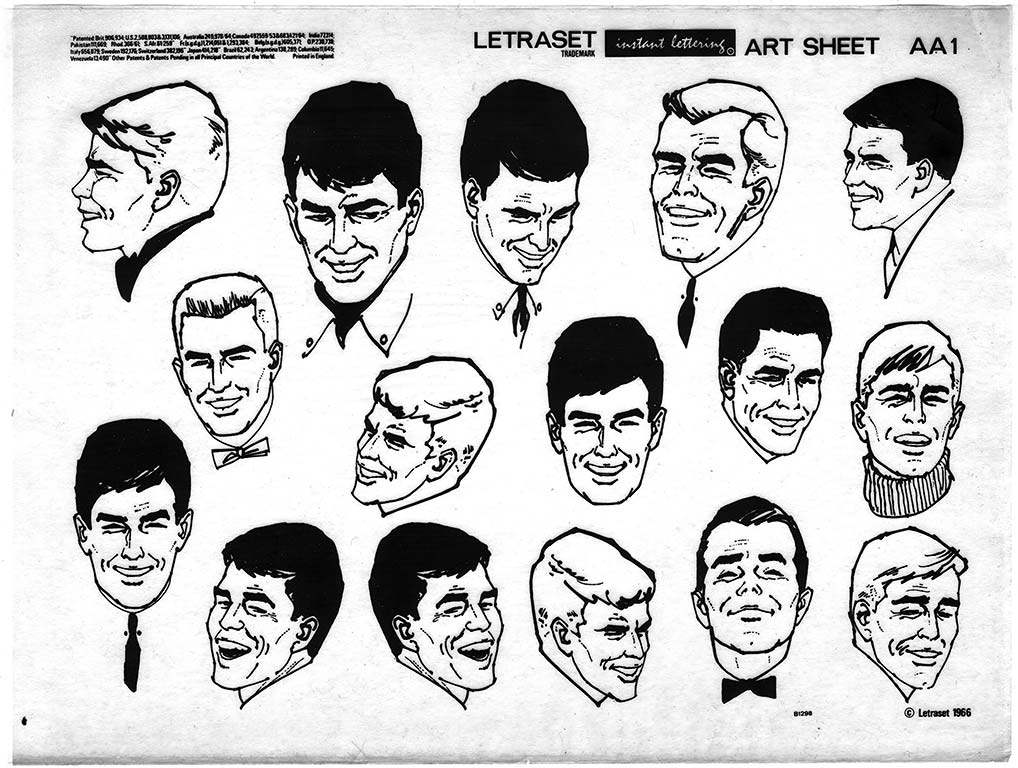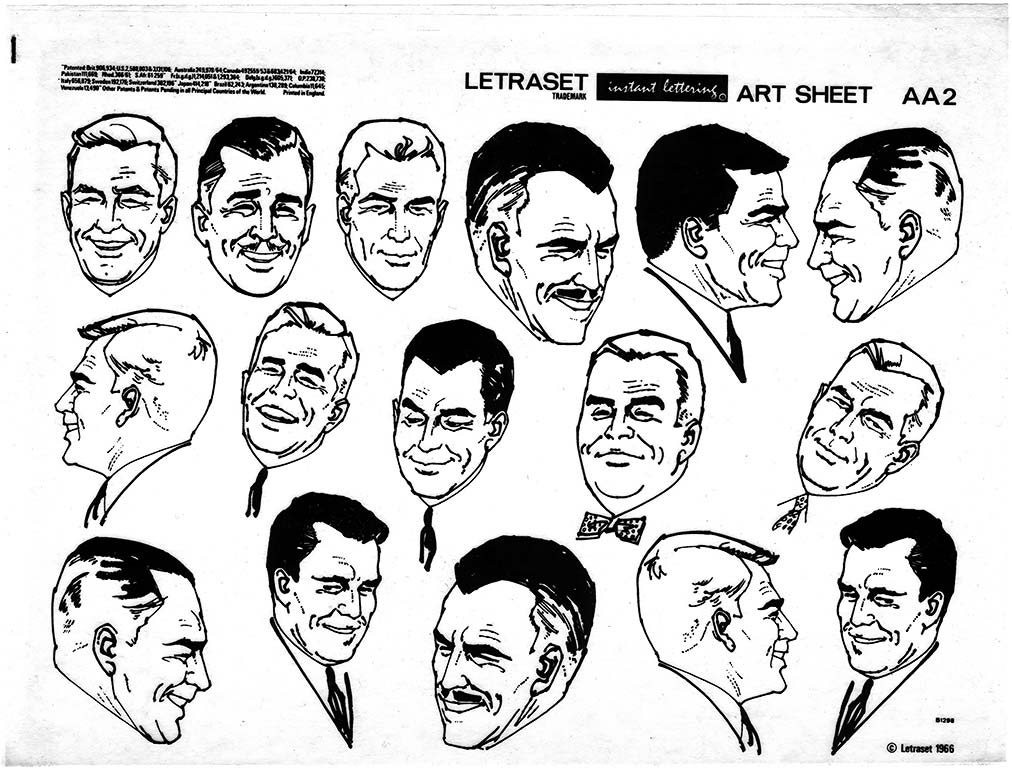This is one of five articles on Letraset products which are not Action Transfers, but which should be of interest nevertheless.
You can get from each article to any of the others by following these links; they are all worth a look.
- Art Sheets (this page; see below ↓)
- Letraset Specials → (featuring 'Yellow Submarine' & Armed Forces sheets)
- Instant Lettering → (plus Symbols & other transfer links)
- Titles for Electronic Equipment →
- The Letraset Type Lettering System → (Letraset's original 1959 product!)
Art Sheets (Page One of Four)
This page from a Letraset catalogue shows some of the products Letraset produced in the 1960s & 1970s. Of particular interest are the 'Special Sheets' (which get their own page) & 'Architectural Symbols' (which get a mention on the 'Instant Lettering' page). However, this page concerns 'Art Sheets'.

Letraset invented Clip Art.
Just as Instant Lettering revolutionised typography, so did Art Sheets transform design. Cheap quickie design, at any rate. You no longer had to employ an artist for every flyer & ad that needed to be done inexpensively or in a hurry; now you could just bung one of these graphics in among the type (Instant Lettering, no doubt), & Bob's your Uncle.
Of course, everybody did, & there's the rub. The things turned up everywhere. They were so ubiquitous that by the time of punk, they took on an ironic hue & got a second shot at everlasting fame.
So the chances are that you will recognise them, if not from 1966, then from 1976… or 1986… or 1996…

Above, the catalogue shows all forty sheets from 1966. However, we don't actually have all of them, & some we have borrowed from contributors rather than from the SPLAT Archives, but you will get the gist.
Now, I expect you would like to know who was responsible for the idea in the first place, & who drew the distinctive illustrations?

The artist was Aubrey Rix, who had a very distinguished career in commercial illustration. You can search online for more information about him; for example, his Daily Telegraph obituary (18th June 2002), where it is noted that "in later life he sustained a considerable setback when he designed hundreds of stock drawings for a lettering company, which were then used copyright free". In other words, designing Letraset Art Sheets turned out badly for him in the long run.
In the meantime, it turned out very well for the thousands of designers who were able to produce illustrations for a fraction of the usual cost, & of course we are grateful too.

The original concept for Art Sheets, & many others of these products, not to mention Busy Bees & Panoramas (& therefore Action Transfers) came from Patrick Tilley, who told me:
"My time with Letraset began with the initial approach by Dai Davies looking for new applications of his baseline product and ended a year or so later when Letraset passed the ball to Waddington's.
"While working closely with Dai, I came up with the concept for sheets of rub-down illustrative elements which could be combined for DIY ads.
"We commissioned Aubrey Rix — represented by Artist Partners — to do the drawings.
"I also worked on their promo material for Texture Sheets and… finally — suggested that Letraset should branch out into a wider range of artist materials. Which they did quite successfully.
"I pitched the idea over one of our lunches when Dai told me about his early struggles to get Rub-Down lettering accepted. He approached Winsor & Newton as a potential saviour but the Board of directors turned him down saying that they thought it 'would impact on their sales of Indian Ink'.
"That's when I suggested he went into the art materials business adding 'if it works as I'm sure it will, you'll be able to buy them out'."
(P.S.: on August 5th 1976, the Times announced that Letraset had acquired a 20.6% holding of Winsor & Newton and was planning to make a full bid for the remaining shares.)

(P.P.S.: It seems Letraset didn't succeed in buying Winsor & Newton in 1976, because Reckitt & Colman did so that year. But it doesn't end there; in 1990, Reckitt & Colman sold Winsor & Newton to AB Wilhelm Becker for their artist's materials division, ColArt. The final twist: in June 2012, ColArt purchased Letraset.)



For convenience, I've spread these Art Sheets over four pages. Keep reading to find out where we got ours, & what happened when Letraset felt the need to update…
• Next Page →- Art Sheets (this page; see above ↑)
- Letraset Specials → (featuring 'Yellow Submarine' & Armed Forces sheets)
- Instant Lettering → (plus Symbols & other transfer links)
- Titles for Electronic Equipment →
- The Letraset Type Lettering System → (Letraset's original 1959 product!)